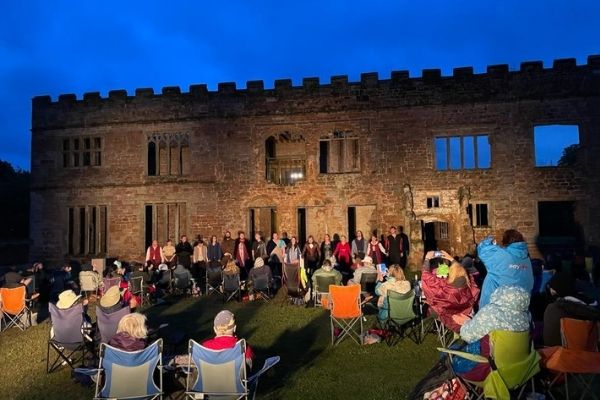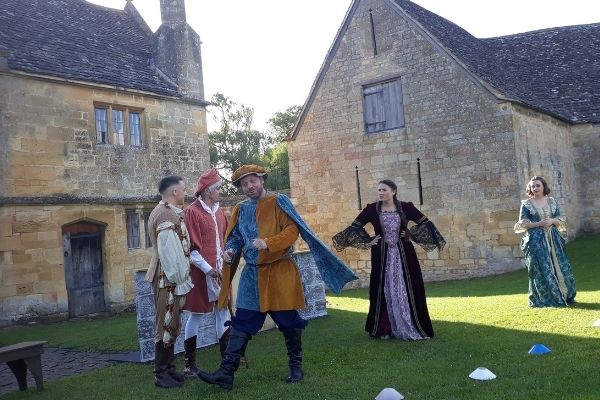This green plot shall be our stage…. (Peter Quince, MND, Act 3 sc i)
For several years now, we have been delighted to host open air Shakespeare at several Landmarks, welcoming amateur theatre company, Sudden Impulse of Nuneaton to (so far) Old Campden House, Astley Castle and Llwyn Celyn. In each, the architecture forms a stunning backdrop to the performance: imagine using Sir Baptist Hicks’ West Banqueting House and Almonry as scenery and as ‘tiring houses’, and entering the ruined atrium at Astley as their wings.

The annual performances have built up a firm following among locals and almost always sell out whatever the weather. Audiences turn up as soon as the gates open with their picnics, chairs, rugs and bottles of wine, and it can be specially endearing to see young children, coming for their first ever taste of Shakespeare and sitting entranced by the wonder of the words and the scene. There seems always to be a fine sunset: then dusk falls, bats slice the air and the magic only increases.
After a run of comedies, this year’s choice was Romeo and Juliet, and after so long with theatres dark due to the Covid pandemic, the excitement at seeing live theatre again was palpable on the nights. There are many precedents for being ordered to close in times of plague (and indeed of Puritans) – in Shakespeare’s lifetime there were several long periods when London’s theatres were shut down. But that did not prevent open air productions.
So it was interesting for me this year to compare Sudden Impulse’s performance at Campden with a (socially distanced) Midsummer Night’s Dream at The Globe I was lucky enough to see the following night. The two ‘auditoria’ are equally authentic representations of Shakespearian theatre: the sophisticated London theatres, sponsored and regulated by the Court, and the provincial players, who disseminated the plays du jour to eager audiences outside London.
Shakespeare in his own work also represented the meta-reality of players-within-a-play (Hamlet, Midsummer Night’s Dream) as well as frequently using the stage as a metaphor for life. I found it interesting to note that Sudden Impulse gave the Globe’s professional actors a run for their money in terms of respect for, and delivery of, the great Bard’s words. I hope they won’t mind if I also say with the greatest affection that, in these settings so close to Shakespeare’s Stratford-upon-Avon, the Mechanicals of Midsummer Night’s Dream are invariably called to mind when I watch their work and applaud the young cast’s progress year on year.

Shakespeare surely gives us pen-portraits from his own experience of local players in Peter Quince the carpenter, the unlikely playwright, and his co-thespians Snug the joiner, Flute the bellows-mender, Snout the tinker, Starveling the tailor and finally the unforgettable ‘bully Bottom’ the weaver. They are played best for me when they bring they own regional accents to the parts.
And this parallel has been doubly brought home to me this spring while researching A Yorkshire Tragedy, the play written in 1605 about the tragic events at Calverley Old Hall. I stumbled across a reference to Cholmeley’s Players, a Catholic recusant acting company of part-time players based in Yorkshire, formed under the patronage of Sir Richard Cholmeley of Whitby and Roxby. The Calverleys of Calverley Old Hall were also Catholics and therefore recusants, at odds with the religion of Elizabeth I’s regime, fined for their faith and barred from local office.
Cholmeley’s Players had formed by at least 1606 and were led by Christopher Simpson, who was both a Catholic and – a shoemaker. Four other members were also Simpsons, presumably family members. Under Cholmeley’s patronage, the troupe’s tours covered most of Yorkshire, performing to recusant gentry households from Whitby on the coast to Gowthwaite deep in Nidderdale in the West.
By 1609, they were a Company of fifteen and included two young apprentices of 14 and 15 years old. One of them, Thomas Pant testified that ‘I was born in Yorkshire & . . . was bound prentice when I was about 12 years of age to one Christopher Simpson a shoemaker. & . . . Simpson with others did use to play plays in the winter time in towns and gentlemen’s houses & did train me up.’ William Harrison was the principal comedian and acted the fool's or clown's parts.
At Christmas 1609 for example, they performed at Gowthwaite Hall to an audience of 100, with sixty more kept out of the great hall, consoled by a gift of money. The players were only licensed to perform plays cleared by the King’s Master of Revels – but of course what’s on the page may not always be what’s spoken on stage.
We know about Cholmeley’s Players because, at a time when suspicion of Catholic conspiracy ran high, they came to the attention of the Star Chamber (an arbitrary law court that became synonymous with repression). The players were accused of using their performances to spread sedition. They swore before the Star Chamber that their repertoire consisted of only printed books: ‘these plays which they so played were usual plays. And such as were acted in Common and public places and Stages . . .and such as were played publicly and printed in the books.’ We will never know the truth of this for sure, but happily Cholmeley’s men continued to perform until at least 1616.
James I’s reign was a time of masques and plays. It’s very likely that Sir Edward Chamberlain at Astley Castle and Sir Baptist Hicks in Chipping Campden welcomed such provincial players to perform in their own great halls and gardens, and the troupes no doubt seized the chance to perform in local taverns and church houses as they travelled. Sir Baptist Hicks’ brother Sir Michael Hicks set up a wedding masque for an unidentified friend in 1604, lent an organ for use in a 1607 royal entertainment by Ben Jonson, and held a country house masque of his own in January 1609. He invited Sir Baptist, but Sir Baptist excused himself, because he was already invited to the Queen's Twelfth Night masque.
How many other Landmarks must have witnessed such theatricals in past centuries? We can be sure that in offering Landmark’s ‘green plots’ to the players as their stages each June, we are merely continuing a long and precious historical tradition.
With thanks to Martin Wiggins for his invaluable advice on early 17th-century theatre. Any remaining mistakes are my own.
See also Charles Sisson, ‘Shakespeare Quartos as Prompt-Copies’, Review of English Studies 18 (1942): 129-143.
Back to the History hub